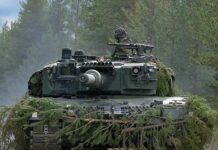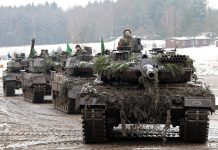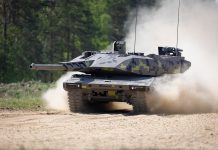Tanks provide a vital form of fire support in Ukraine, which means that both sides rely extensively on high explosive (HE) and guided ammunition natures.
If you watch enough videos and read enough reports, you will get a sense of the vast scale of Ukraine. It is more easily appreciated by driving; even the relatively populated route from Lviv to Kyiv will travel through hundreds of kilometres of open fields. The occasional settlement breaks up what is otherwise uninterrupted terrain that is mostly flat with some large hills. The country has a total land area of 579,330 km2, with another 24,200 km2 of water – this makes it twice the size of Italy, not much smaller than France, and about 14 times the size of the Netherlands. Much of Ukraine is made up of similar terrain except for the Carpathian Mountains that form a natural barrier with Romania, Hungary, and Slovakia.[1] The Dnipro River is one of Ukraine’s most dominant features, it runs from north-to-south and empties into the Black Sea, it averages 80 – 400 m along its length, and has a maximum width of 7 km near a dam in Zaporizhzhia.[2] Forests cover around 16.7% of Ukraine, but their distribution is uneven.[3] The northern and western regions boast higher proportions of woodland, while the southern and eastern regions transition into steppe landscapes with little to no woodland. The northern and western regions are home to most of Ukraine’s wetlands, with others located in river floodplains; this accounts for another 1.7% of Ukraine’s land.[4]
In theory, this is the type of topographical description that lends itself to large meeting engagements of tanks and armoured vehicles. In fact, during World War II, Germany’s 1st Panzer Group met the Soviet 5th and 6th Armies around Brody in 1941. Some estimate that there were 5,000 tanks involved in that battle, which ultimately ended in favour of the 1st Panzer Group.[5] Yet during Russia’s war against Ukraine, there have been remarkably few sweeping advances, and even fewer meeting engagements between massed ranks of armour. There are many reasons for this; the persistent ISR of both sides with effective and short artillery targeting cycles make attempts at concentrating armour ill-advised. Equally, the prevalence of anti-tank guided missiles (ATGMs) means that infantry are more easily able to break up and absorb an armoured advance than their WWII predecessors. In some areas, Russian forces did advance with relative speed at the start of the war. In those areas that had been fought over since 2015, however, they were slowed by Ukrainian fortifications and resistance. The scale mentioned above, combined with extensive attrition, also seems to lead to a lack of available armour.
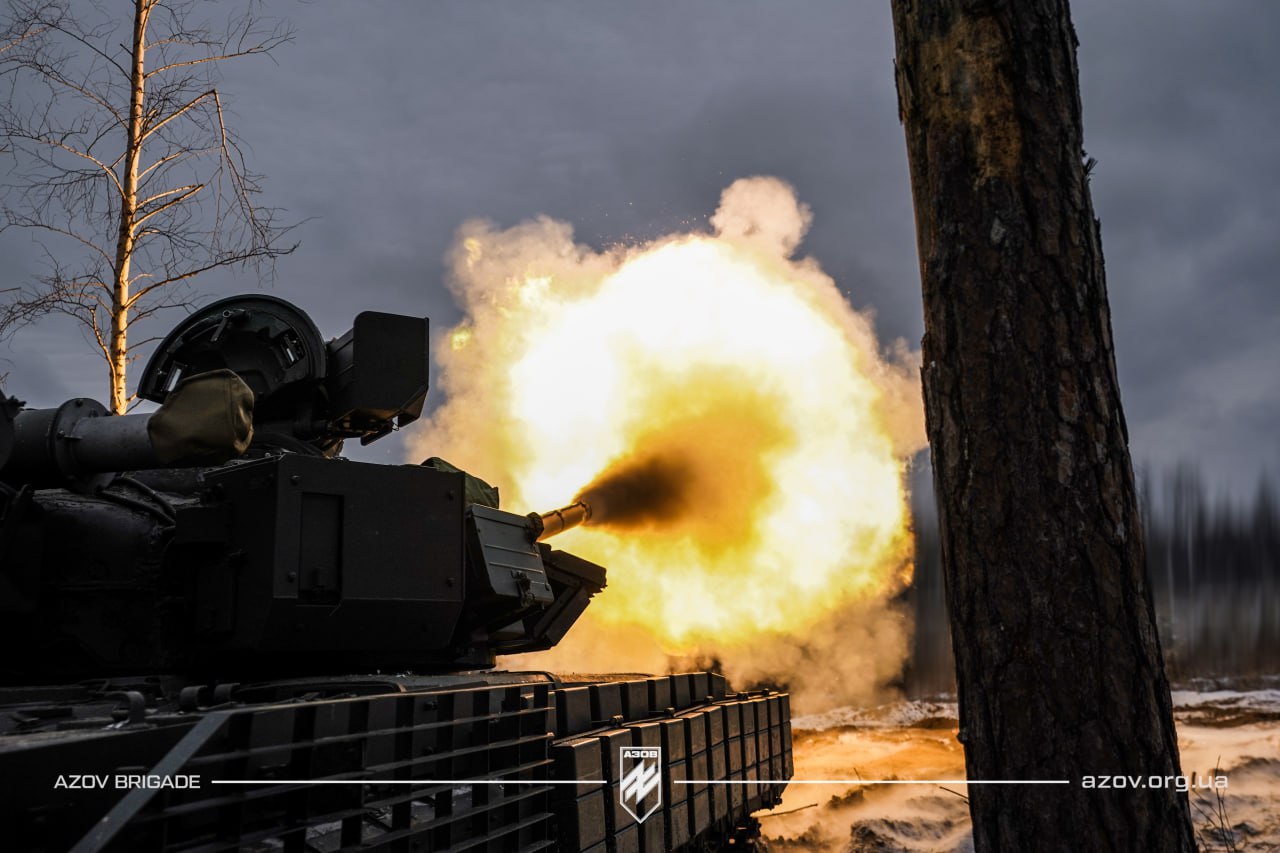
Credit: National Guard of Ukraine, via Wikimedia Commons
This means that Russian and Ukrainian tanks rarely meet, and if they do, engagements are between a few vehicles and short. As a result of this, the armour piercing fin stabilised discarding sabot (APFSDS) rounds that have shaped and defined armour-on-armour engagements for a generation, are not the most important large-calibre nature used by armoured vehicles in the war. That title belongs firmly with the HE rounds and gun-launched ATGMs (GLATGMs).
Accurate, immediate, and deadly
Tanks have come to play a key role in Ukraine through the provision of fire support against fortified positions, snipers, and vehicles. The Russian’s had explored this tactic prior to the invasion by pairing Orlan-10 drones with tanks to create a tactical reconnaissance-fire capability.[6] The majority of fires are conducted at low angles, making it essentially direct fire. The primary ammunition used for this type of mission is HE, the Soviet era tanks employed by both sides may have access to the 125 mm 3VOF36 round, which consists of the 3OF26 high explosive fragmentation fin-stabilised munition, a V-429E or V-429V fuze; and either a 4Zh40 or a 4Zh52 rear propelling charge.[7] The 3OF26 projectile has a weight of 19.4 kg and can be fired to a maximum range of 10 km. It has a steel body, and carries 3.4 kg of A-IX-2 explosive material, constituting 14.8% of the projectile’s total weight. The fuze is a point detonating type but it can be set to delayed activation.[8] A-IX-2 is a Russian explosive that consists of 73% RDX, 23% aluminium powder, and 4% wax as a phlegmatiser, which is used to stabilise the RDX and make it less sensitive.[9] The four fins at the rear impart a slow rate of spin, but this spin is not involved in arming the fuze.[10]
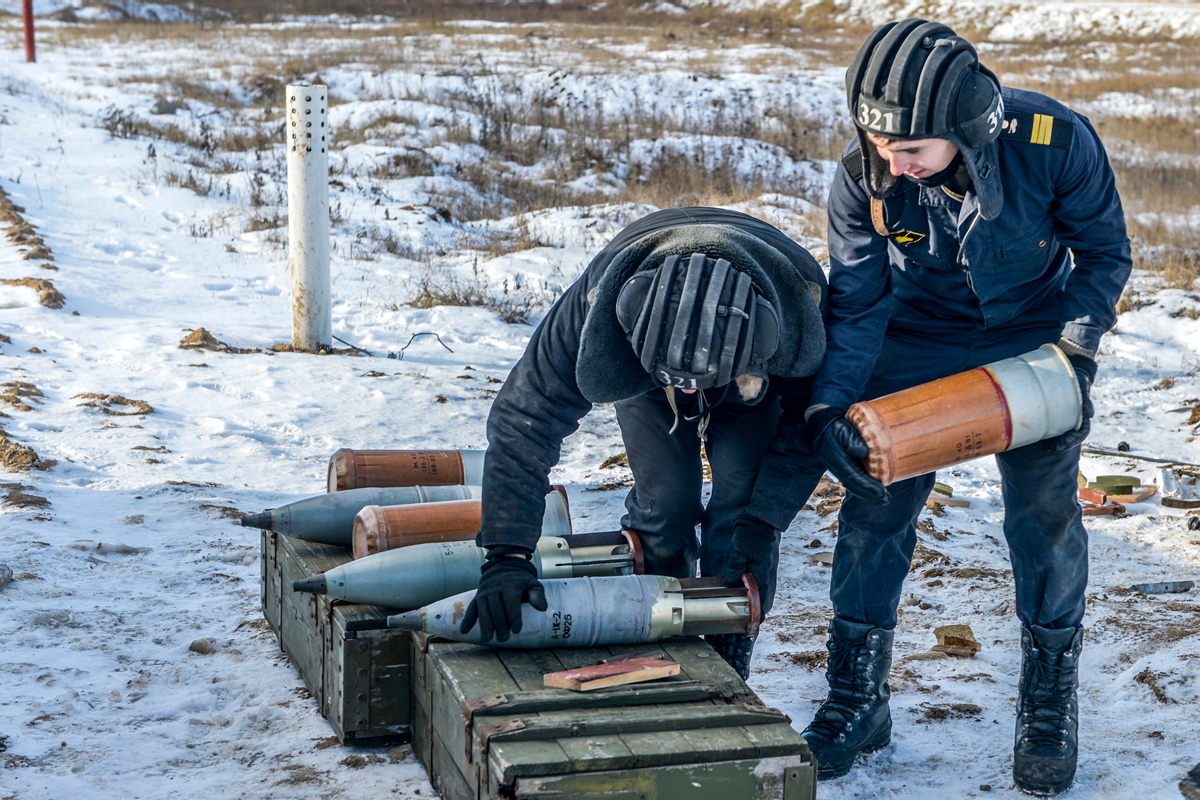
Credit: Russian MoD
The 3OF26 will deviate up to 0.23 m from the line of shot for every 1,000 m it travels. However, one Russian source from 2005 indicates that the round is much less accurate, with sufficient dispersion at 2,000 m that makes it difficult to use reliably. The round is also made from a steel alloy that lends itself to ‘hot stamping’ for production, but inefficient creation of fragmentation.[11] The author uncharitably referred to the 3OF26 as ‘technology from the 30s’. He also noted that the impact fuze was limited and could not be used during rain or hail. An alternate fuzing system was developed for use with the Aynet fire control system in the T-90K and T-80UK tanks. It employed the 3VM17 and 3VM18 electric fuzes that were programmed as the round was loaded, enabling the crew to fire high explosive rounds with an airburst detonation. The Russian author noted, however, that the fire control system was not capable of reliably producing the kind of accuracy needed for this, as shells would have a 0.001 second window in which to detonate above an enemy trench.
The theoretical outcome, or supposed outcome of combat based on assessment of the technology in a vacuum is not always an accurate reflection of the real world outcomes, however. The following is an account of a Western volunteer fighting in Ukraine in 2022:
“I had [taken] a position with the PKM just to the right of everyone else in a small little ‘L’ shape type of trench. Every so often we would hear enemy drones flying over us and not long after would hear tank rounds getting fired. There [were] some [which] were hitting in a field not too far from us. About 5 minutes after that I could hear the sound of a drone coming towards us. It was right over me and I was expecting it to carry on moving, but this time it never did. I heard the drone get loud as it hovered over me and within about 10 seconds I heard the sound of a tank fire. Next thing I see was a red flame and hear a loud bang. I got instant ringing in my ears I couldn’t hear nothing [sic]. ‘Are my friends okay?’ is the first thing I thought. At first I thought shrapnel had went into my left hand, I felt the impact from the blast hit my left side. I knew I needed to get to a better trench, so I ran to a trench [which] had better cover for me.”[12]

Credit: National Police of Ukraine, via Wikimedia Commons
There are many accounts of Russian tanks employing high explosive shells in this way. Some reveal startling accuracy – first round strikes against a few isolated personnel, rounds bursting through walls of buildings that tear helmets from heads and shower infantry in fragmentation. It is also understood that tanks are used in conjunction with drones to improve their accuracy. Some accounts indicate that tank rounds are especially demoralising, because they provide no indication of their approach like artillery shells. Direct fire support is conducted at distances of 2 km from Ukrainian positions. With a muzzle velocity of 850 m/s, the 3OF26 will reach a target in around 3 seconds. Russian forces will fire large quantities of rounds at a target and relocate before return fire is generated. In many ways, the 3OF26 is one of the most important tank rounds for the Russian armed forces, it is valuable in an urban fight, as well as against fortifications.[13]
Advanced types
The Russians are not alone in using tank armaments for fire support; Ukraine has made use of its Soviet-era tanks as well as newer platforms from the West in this role.[14] Ukraine operates a veritable zoo of armoured vehicles, so it is not possible to explore every type of ammunition that they may have been provided. However, there is evidence of Ukraine receiving the 120 mm DM11 high explosive round with a programmable fuze from Germany.[15] This is arguably one of the more advanced HE natures in use in Ukraine. It contains 2.17 kg of HE filler and 6,000 tungsten balls located in the tip of the warhead, all surrounded by a strong steel casing that enables the round to be used against bunkers and walls. It has a muzzle velocity of 1,000 m/s when fired from the L55 gun of a Leopard 2A6 and a programmable fuze in the base of the munition.[16] The munition is stabilised by four folding fins at the rear and is provided as a single piece round with propellant attached. It was required to have a range of 5,000 m and be lethal to lightly armoured vehicles like BTRs, and capable of disabling 50% of an infantry squad in a wedge formation with two shots. Upon detonation the DM11 generates a total of 13 kg of fragments including the tungsten balls.[17] If a fuze programming kit is not fitted, the Rh31 round can be used as an alternative to DM11. This uses the same warhead as DM11, but the round is only fitted with a point detonating fuze, and has a lower effective range of 3,500 m.

Credit: Bundeswehr-Fotos, via Wikimedia Commons
Russia has developed its own air-bursting round for tanks, which is designated 3VOF128 Tel’nik and was reported to be in use with Russian forces in October 2023.[18] It is fitted with the 3VM18 fuze, has a total projectile weight of 23 kg, including 3 kg of explosive filler and a 1.6 kg fragmenting element designed to disperse the 450 pre-formed fragments in a cone pattern.[19] Of the tanks used by Russia in Ukraine, Tel’nik can only be fired by the T-90M, as it requires the use of a compatible fire control system and ballistic computer for programming of the fuze.
Russian and Ukrainian tank crews have also made use of GLATGMs for precise strikes against ground-based ATGM teams and other isolated targets. The missiles provide greater range and accuracy than other forms of tank-fired munition, which makes them a valuable weapon to stay beyond the reach of weapons such as Javelin.[20] The 9M119M Invar is one example of a GLATGM employed by Russian forces. The complete system is designated 9K119M Refleks-M, and it consists of the guided 9M119M Invar projectile, and the 9Kh949 ejector which pushes the missile out of the barrel, as well as a guidance system inside the tank turret. It employs laser beam riding for its semi-automatic command to line-of-sight (SACLOS) guidance, employing an encoded laser beam to send guidance corrections to a receiver located on the base of the missile in flight. Refleks-M has a range of 5 km, and takes 14 seconds to reach its maximum range, powered by a solid propellant motor. The warhead weighs 4.5 kg and is a tandem high explosive anti-tank (HEAT) nature, designed to penetrate tanks protected by explosive reactive armour (ERA).[21] Like the 3OF26, GLATGMs are used against defences and stationary positions too, their accuracy providing a form of precise fire for frontline units.[22]

Credit: Vitaly Kuzmin, via Wikimedia Commons
Indirect fire; a waste of time?
Soviet tankers were taught indirect fire as far back as WWII, on various tanks such as T-34 and IS-3. Each tank was equipped with an indirect fire azimuth indicator that had to be dismounted for use, as well as an elevation quadrant mounted on the gun carriage. The azimuth and elevation devices were used to measure gun orientation and elevation for indirect fire, and the gunner would conduct calculations to get the rounds onto a target. They considered anything beyond 2,500 m to be a valid indirect fire target and the command sequence to fire would begin with the azimuth, elevation, and type of ammunition. The commander might also give instructions on the type of fire – three round volley fire for instance.[23]
In later designs such as the T-72, a turret azimuth indicator is included inside the turret and used to provide a precise indication of the turret’s orientation for indirect fire. The sighting system on the standard T-72s provides fire control solutions and ballistic calculations out to 4,000 m for direct fire. Indirect fire at ranges beyond this is likely closer in methodology to the aforementioned T-34 scenario. This form of fire is relatively ineffective and produces a wide dispersion of impacts. However, it appears to be used to some extent in Ukraine as a means of generating harassing fire or of supporting artillery fire. This is especially the case where Russian units are lacking artillery. Ukrainian units have also reportedly made good use of indirect fire from tanks and employed digital methods of fire correction.
In sum
Perhaps past battles in WWII, the 1973 Arab-Israeli war, or the 1991 Gulf War are responsible for the impression that tanks should be fighting other tanks? There are many wars where tank-on-tank combat has formed a minor, almost unimportant role for heavy armour. Most recently, Chechnya, Syria, Iraq during the 2003 invasion and again during the fight against ISIS, their primary role has been in fire support of infantry operations. In that sense, the weight of history suggests that we should have expected tanks to primarily provide fire support with high explosive and other ammunition natures rather than being limited to high intensity combat against other tanks with APFSDS rounds.
Sam Cranny-Evans
[1] Ukraine – The World Factbook
[2] Dnieper River | Physical Features & History | Britannica
[3] Forest resources and context of Ukraine
[5] https://warfarehistorynetwork.com/article/battle-of-brody-disaster-along-wwiis-eastern-front/
[6] https://www.dupuyinstitute.org/blog/2018/02/21/russian-army-experiments-with-using-tanks-for-indirect-fire/
[7] https://fenixinsight.com/munition/projectile/3vof36
[8] 125 mm Round 3VOF36 with High Explosive Fragmentation Fin Stabilized Projectile 3OF26 (HE/FRAG-FS) For 125 mm tank gun 2A46/D81 – Arcon partners ltd
[9] Soviet 3O8 240 mm rocket-assisted cargo projectiles in Syria – Armament Research Services (ARES)
[10] EXPLOSIVE ORDNANCE GUIDE FOR UKRAINE
[11] Танк в опасности / Вооружения / Независимая газета
[12] Battles and Beers: War Stories
[13] https://www.instagram.com/p/CmKf3m2gBmb/?next=%2Foabfranca%2F&hl=pt
[14] https://www.youtube.com/watch?v=E2C2AIjZHOM
[15] Armed Forces use DM11 ammunition with programmable detonation. VIDEO
[16] https://www.kaskus.co.id/thread/5475c16bdc06bd4d5d8b4571/correct-shell-for-the-right-purpose
[17] 120mmsystemhouse – rheinmetall – 120mm smoothbore system house superior firepower against multiple battlefield threats
[18] Russian Programable Ammunition in Combat – Armada International
[19] Россия начала применять на Украине новый танковый осколочно-пучковый снаряд 3ОФ82 «Тельник
[20] Preliminary Lessons in Conventional Warfighting from Russia’s Invasion of Ukraine: February–July 2022 and Preliminary Lessons in Conventional Warfighting from Russia’s Invasion of Ukraine: February–July 2022
[21] http://fofanov.armor.kiev.ua/Tanks/ARM/refleks.html
[22] https://www.instagram.com/p/CwsadwTMDZh/?next=%2Foabfranca%2F&hl=pt





